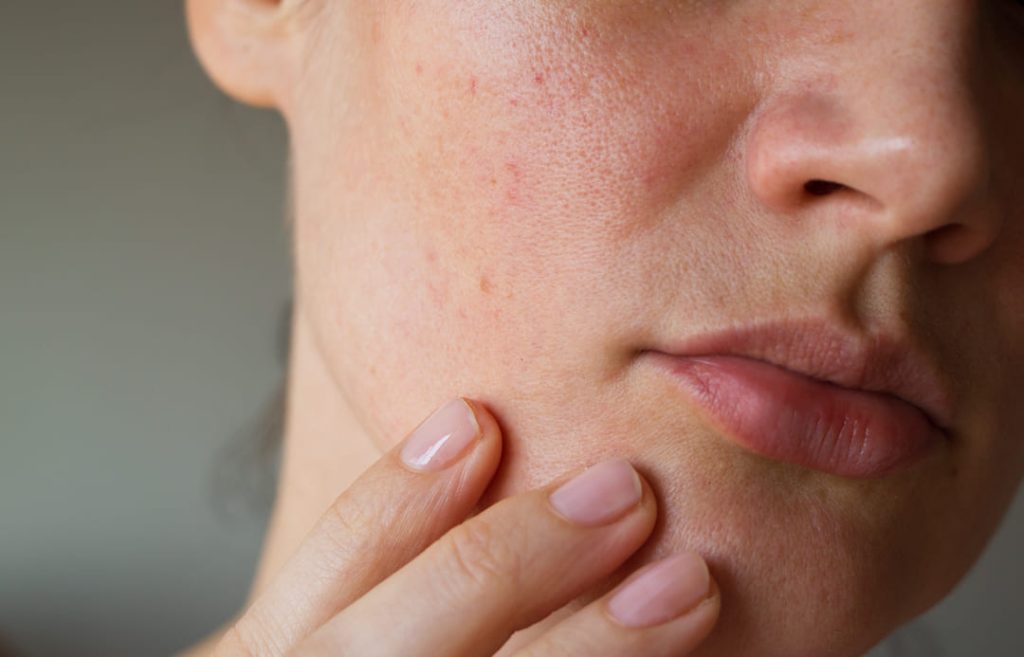Looking for Expert-Level VA Claim Answers?📱Call Us Now! 737-295-2226
If you’re a veteran struggling with eczema, contact dermatitis, or another type of chronic skin condition, you may be eligible for monthly VA disability compensation.
Dermatitis is a common condition among veterans—often triggered by harsh environments, allergens, or stress during service. But many veterans don’t realize how the VA rates dermatitis—or how to prove it’s service-connected.
In this post, we’ll walk you through how to qualify for a VA rating for dermatitis, how the VA determines your percentage, and how to strengthen your claim.
Table of Contents
Summary of Key Points
- Dermatitis is rated under VA Diagnostic Code 7806 using the General Rating Formula for the Skin, with ratings ranging from 0% to 60% depending on the severity and treatment required.
- Common types include atopic dermatitis (eczema), contact dermatitis, seborrheic dermatitis, and neurodermatitis (all evaluated under the same VA rating criteria).
- To qualify, veterans need a current diagnosis, persistent symptoms, and a service connection through direct, secondary, or aggravation-based linkage.
- VA benefits vary by rating level, ranging from free VA healthcare to monthly compensation, home loan waivers, and more, especially for 30%+ or unemployable veterans.
Types of Dermatitis Rated by the VA

Specific types of dermatitis don’t appear in Title 38 of the US Code of Federal Regulations (the title that governs the VA). This means there is no specific seborrheic dermatitis VA rating, for example. Only the broad term “dermatitis” appears in CFR 38, which encompasses many skin conditions, including the following:
- Atopic dermatitis. Also known as eczema. This type of dermatitis occurs when your skin’s barrier function is damaged. Symptoms can be triggered by food allergens, such as peanuts, tree nuts, eggs, soy, cow’s milk, wheat, shellfish, and seafood.
- Contact dermatitis occurs when you come into contact with something you’re allergic to.
- Neurodermatitis is observed to be caused by stress, anxiety, depression, nerve injuries, and other skin conditions.
- Nummular dermatitis. This type of dermatitis can be caused by exposure to rough fabrics (like wool), dry environments, skin trauma, or injury (like a burn, scrape, or bug bite).
- Seborrheic dermatitis can be aggravated by dry and cold climates. Other possible causes include stress and an increased level of androgens.
How the VA Rates Dermatitis
Dermatitis is rated under Diagnostic Code (DC) 7806. Diagnostic codes are unique, 4-digit codes the VA uses to identify conditions evaluated for VA disability benefits. Usually, a diagnostic code will have rating criteria included with it that specify what rating percentage should be awarded for what symptoms.
But under diagnostic code 7806 is a little note that says, “Evaluate under the General Rating Formula for the Skin.”

This formula is how the VA rates most skin conditions, and it primarily considers these two factors:
- The extent to which dermatitis lesions affect the body.
- The frequency of immunosuppressive drug usage needed to manage dermatitis
Based on these factors, dermatitis VA ratings can be either 0%, 10%, 30%, or 60%. Each percentage corresponds to specific criteria that are laid out in the rating chart.
Check out the VA rating chart for skin conditions below 👇 It doesn’t matter if you have atopic dermatitis or neurodermatitis; if it produces these symptoms, you could be eligible for a VA rating for dermatitis.
Dermatitis VA Ratings Chart
| General Rating Formula for the Skin | VA Rating |
| At least one of the following: Characteristic lesions involving more than 40 percent of the entire body or more than 40 percent of exposed areas affected; or Constant or near-constant systemic therapy including, but not limited to, corticosteroids, phototherapy, retinoids, biologics, photochemotherapy, psoralen with long-wave ultraviolet-A light (PUVA), or other immunosuppressive drugs required over the past 12-month period | 60% |
| At least one of the following: Characteristic lesions involving 20 to 40 percent of the entire body or 20 to 40 percent of exposed areas affected; or Systemic therapy including, but not limited to, corticosteroids, phototherapy, retinoids, biologics, photochemotherapy, PUVA, or other immunosuppressive drugs required for a total duration of 6 weeks or more, but not constantly, over the past 12-month period | 30% |
| At least one of the following: Characteristic lesions involving at least 5 percent, but less than 20 percent, of the entire body affected; or At least 5 percent, but less than 20 percent, of exposed areas affected; or Intermittent systemic therapy including, but not limited to, corticosteroids, phototherapy, retinoids, biologics, photochemotherapy, PUVA, or other immunosuppressive drugs required for a total duration of less than 6 weeks over the past 12-month period | 10% |
| No more than topical therapy required over the past 12-month period and at least one of the following: Characteristic lesions involving less than 5 percent of the entire body affected; or Characteristic lesions involving less than 5 percent of exposed areas affected Or rate as disfigurement of the head, face, or neck (DC 7800) or scars (DCs 7801, 7802, 7804, or 7805), depending upon the predominant disability. This rating instruction does not apply to DC 7824 | 0% |
Qualifying for a Dermatitis VA Rating
All VA disability benefits are only available to veterans who meet the qualification criteria.
Those criteria include:
- A current diagnosis. The VA can’t rate a condition that hasn’t been formally diagnosed by a qualified medical professional.
- You have persistent and recurring symptoms. Even if you have a recent diagnosis, if your symptoms go away, you aren’t eligible for a VA rating.
- Specific service requirements.
- Proof that your military service caused your disability or made it worse. This is known as “service connection.”

How to Get a Dermatitis Diagnosis
If you don’t already have one, you’ll need a current and official diagnosis from a qualified medical professional.
“Current” means that you still have symptoms. If you were diagnosed with dermatitis in the past, but it got better, your diagnosis is no longer current. You need to have symptoms of dermatitis in the present day. This is what is meant by “persistent and recurring.”
The VA accepts diagnoses from any qualified medical professional, private or VA-affiliated. But if you get one from a private physician, you could be left footing the bill.
If you’re already enrolled in VA Healthcare and registered as a patient with your nearest VA medical center, you may be able to get a diagnosis for free.
Service Requirements
Service requirements vary depending on the benefit. For monthly compensation, the service requirements include:
- Have served at least 90 days on active duty, active duty for training, or inactive duty for training
- Not have received an Other Than Honorable, Bad Conduct, or Dishonorable discharge
You’ll need to submit your DD-214 with your VA claim to show that you have qualifying service.
Service Connecting Your Dermatitis
You can only get a dermatitis VA rating if your military service caused your dermatitis or made it worse. This is known as “service connection.”
Types of Service Connection
- Direct Service Connection is when your military service is directly responsible for your current condition.
- Presumed Service Connection refers to conditions the VA automatically assumes were caused by military service. For example, it’s assumed all service members who served in the Vietnam War were likely impacted by Agent Orange. So, if their disability is on the Agent Orange exposure presumptive list, and they meet the service requirements, their conditions is assumed to be service-connected.
- Pre-Existing Conditions Aggravated by Military Service apply to disabilities that worsened due to your time in the military.
- Secondary Service Connection refers to a condition that is caused or aggravated by a direct service-connected (primary) disability. These are known as “secondary conditions.”
- VA Medical Malpractice – Any condition or injury worsened or caused by the malpractice or negligence of the VA, which is called a TORT claim/ connection.
When it comes to dermatitis, your best bet for service connection is through direct or secondary service connection.
Direct Service Connection
If you already have a dermatitis diagnosis, you need two other things to establish direct service connection:
- Evidence of an in-service event, injury, or illness. This is the military-related incident you’re claiming is responsible for your dermatitis. This could be found in your military medical records or other military records. It can also come in the form of personal statements from yourself, your family, or others who were there at the time.
- A medical “nexus” (link) between your dermatitis and your in-service event, injury, or illness. Does the medical evidence suggest that your in-service event, injury, or illness is at least as likely the cause of your dermatitis? If you get a Nexus Letter, the link will be expressed as one of these statements of probability:
- “Is due to” = 100% certain
- “More likely than not” = greater than 50% certain
- “At least as likely as not” = equal to 50% certain
- “Was less likely” = less than 50% certain
- “Is not due to” = 0% chance
Secondary Service Connection
When filing for dermatitis as a secondary condition, you aren’t required to show evidence of an in-service event, injury, or illness. This is because your primary disability—the service-connected disability you’re claiming is the cause of your secondary condition—serves as the in-service event, injury, or illness.
Claims for secondary service connection also require a medical nexus. But the evidence in your medical records and the evidence collected during any examinations conducted during the claims process must show that your dermatitis is “proximately” due to your primary disability, rather than an in-service event, injury, or illness.

VA Disability Benefits Available with a Dermatitis VA Rating
There are many benefits that come with a VA rating aside from monthly compensation!
Here are some of the top benefits according to rating percentage:
0% VA Rating (non-compensable)
- VA health care, including regular checkups, appointments with specialists, and prescription refills. (if income limits are met)
- Travel pay reimbursement. This program pays you for mileage and other travel expenses to and from approved healthcare appointments at a VA medical facility or a VA-authorized healthcare facility.
- Vision care. You may be able to get some or all of your vision care through the VA.
- Veterans Affairs Life Insurance (VALife). This is low-cost coverage for eligible Veterans with service-connected disabilities.
- 10-point preference in federal hiring
- Use of commissaries, exchanges, and morale, welfare, and recreation (MWR) retail facilities, in-person and online.
10% VA Rating
- All of the above, AND
- Waiver of VA funding fee for home loan
- Vocational Rehabilitation & Employment (with a serious employment handicap)
- Burial and plot allowance
30% VA Rating
- All of the above, AND
- Access to VA Priority Group 2. Priority groups are how the VA distributes medical care. Group 1 is the highest priority.
- Additional compensation for eligible dependents (the 10% and 20% compensation levels do not vary based on family factors).
- 10-point Veteran preference in federal hiring
60% VA Rating
- All of the above, AND
- Access to VA Priority Group 1
- Concurrent receipt of military retired pay. At lower ratings, you have to waive either military retirement pay or VA compensation. You can’t receive both.
- Individual Unemployability. This is when you can’t work because of your service-connected disability. (must be unemployable due to service-connected disabilities)
- Dependents Educational Assistance (unemployable condition must be considered permanent)
- Special restorative training
- CHAMPVA–Civilian Health and Medical Program (unemployable condition must be considered permanent)
- Dental care (if rated unemployable)
VA Disability Compensation
But, of course, a VA rating of 10% or higher also comes with monthly compensation.
Calculate Your Combined VA Disability Rating HERE.
View Current VA Disability Pay Rates HERE.
VA Decision Timeline
The VA decision process is a 5-step process from initial filing to receiving your decision letter. See below for details about each step:
- Claim received. The VA will notify you when they receive your disability claim.
- If you file your claim online, you’ll get an on-screen message from us after you submit the form.
- If you mail your application, you should get a confirmation letter a little more than 1 week, plus mailing time, after they receive your claim.
- Initial review. This is when the VA reviews the documents you submitted with your claim.
- Evidence gathering, review, and decision. If more evidence is needed to decide your claim (it likely will be if you didn’t file a Fully Developed Claim), they’ll collect it during this step. They’ll also:
- Review all the evidence. This includes evidence gathered during your C&P Exam.
- Make a determination of service connection. If they service connect your disability, they’ll also make a rating determination.
- Preparation for notification. During this step, they’ll prepare your decision letter which will be delivered to you through the mail.
- Claim complete. Once you receive your decision letter, your claim is complete! According to the VA, it’ll take 7-10 business days for your decision letter to be delivered.
How Long Does it Take for the VA to Make a Rating Decision?
As of July 2025, the VA takes an average of 100.4 days to complete this process.
The most up-to-date average VA claim timeline is available HERE.
What to Do if You Disagree with Your VA Rating Decision
If you disagree with a VA decision made on or after February 19, 2019, you have three options:
- You can file a Supplemental Claim. This option is best if you have new and relevant evidence that you think could change the VA’s mind.
- You can request a Higher-level Review. This option is best if you think your VA rater made a mistake and you don’t have new and relevant evidence you’d like to submit.
- You can submit a Board Appeal. This option is only available if you’ve already attempted either a supplemental claim or a higher-level review.
KEEP IN MIND: Higher-level Reviews and Board Appeals must be submitted within one year of your original decision letter.
Conclusion
If your military service exposed you to harsh environments, allergens, or stress that contributed to your dermatitis, you deserve the benefits you’ve earned.
Whether you’re applying for the first time or seeking a higher rating, understanding the VA’s rating system and how to prove service connection is key. The more clearly you document your symptoms, treatments, and in-service exposure, the better your chances of a successful claim.
NEED MORE ASSISTANCE? We’ve Got Your SIX.

Most veterans are underrated for their disabilities and, therefore, not getting their due compensation.
At VA Claims Insider, we help you understand and take control of the claims process so you can get the rating and compensation you’re owed by law.
Our process takes the guesswork out of filing a VA disability claim and supports you every step of the way in building a fully-developed claim (FDC)—so you can get what you deserve in less time!
If you’ve filed your VA disability claim and have been denied or have received a low rating—or you’re unsure how to get started—reach out to us! Take advantage of a VA Claim Discovery Call.
Learn what you’ve been missing—so you can FINALLY get the disability rating and compensation YOU DESERVE!
FAQs
How much VA compensation can I receive for dermatitis?
Dermatitis VA ratings range from 0% to 60%. A 10% rating provides monthly compensation and access to additional VA benefits. A 60% rating could qualify you for Priority Group 1 healthcare and potentially Total Disability Individual Unemployability (TDIU) if your condition limits your ability to work.
Can I get VA disability for eczema or atopic dermatitis?
Yes. The VA does not distinguish between subtypes like eczema or atopic dermatitis in its rating schedule. Instead, all are evaluated under Diagnostic Code 7806, based on severity, body area affected, and treatment type.
What if my dermatitis was made worse by my service, but didn’t start in service?
You may still qualify for “aggravated service connection.” If your pre-existing dermatitis worsened during service, and the evidence shows it was more than a natural progression, the VA may award a disability rating.
Can dermatitis be a secondary condition to something else?
Yes. For example, if you’re already service-connected for a mental health condition that causes or worsens stress-induced dermatitis (like neurodermatitis), you can file a secondary claim.
What evidence do I need to support my dermatitis claim?
You’ll need a current diagnosis, medical records showing ongoing symptoms or treatment, and documentation linking your condition to service (like medical records, buddy statements, or a Nexus Letter).
Author

Clay Huston
Clay Huston is a former U.S. Army Reserves Blackhawk Pilot and officer. Clay enlisted in the Army in 2013 and was commissioned as a 2LT in 2017 after earning a business degree from the University of Illinois Champaign-Urbana.
Since separating from the military, Clay has pursued a career as a writer. He also runs the nonprofit notfatherless.org, which fundraises for Children’s Homes in Mexico.


